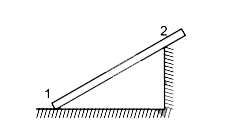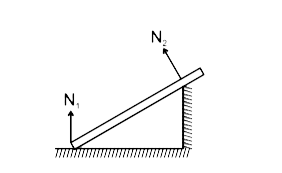Text Solution
Verified by Experts
|
Topper's Solved these Questions
NEWTON'S LAWS OF MOTION & FRICTION
MOTION|Exercise Questions For Practice|25 VideosView PlaylistNEWTON'S LAWS OF MOTION & FRICTION
MOTION|Exercise Exercise - 1 (SECTION-A:- String Constrained, Wedge Constrained, Newtons Law theory Question, Equillibrium Questions (Normal and Tension), Problems with Acceleration (F=ma), Wedge problems)|27 VideosView PlaylistNEWTON'S LAWS OF MOTION & FRICTION
MOTION|Exercise Exercise - 3 Section-B|12 VideosView PlaylistMODERN PHYSICS -1
MOTION|Exercise EXERCISE-4 ( LEVEL- II)|39 VideosView PlaylistNLM & FRICTION
MOTION|Exercise EXERCISE-4 ( LEVEL-II)|15 VideosView Playlist
Similar Questions
Explore conceptually related problems
Knowledge Check
A
B
C
D
Submit
A
B
C
D
Submit
A
B
C
D
Submit
Similar Questions
Explore conceptually related problems
MOTION-NEWTON'S LAWS OF MOTION & FRICTION -Problem
- Draw normal forces on the massive rod at point 1 and 2 as shown in fig...
01:19
|
Playing Now - Three triangular blocks A,B and C of equal masses ‘m’ are arranged as...
02:01
|
Play - The breaking strength of the string connecting wall and block B is 175...
06:02
|
Play - In the arrangement shown in figure, what should be the mass of block A...
01:58
|
Play - Two blocks with masses m(1) = 0.2 kg and m(2) = 0.3 kg hang one under ...
01:45
|
Play - Two blocks with masses m(1) = 0.2 kg and m(2) = 0.3 kg hang one under ...
02:18
|
Play - Two blocks with masses m(1) = 0.2 kg and m(2) = 0.3 kghang one under o...
06:17
|
Play - Two blocks with masses m(1) = 0.2 kg and m(2) = 0.3 kg hang one under ...
04:00
|
Play - Two blocks with masses m(1) = 0.2 kg and m(2) = 0.3 kg hang one under ...
06:18
|
Play - A block of mass 50 kg is kept on another block of mass 1 kg as shown i...
06:48
|
Play - A block of mass 50 kg is kept on another block of mass 1 kg as shown i...
06:48
|
Play - Two forces F(1) and F(2) ( F2 gt F(1)) are applied at the free ends...
04:24
|
Play - A 10 kg block kept on an inclined plane is pulled by a string applying...
03:27
|
Play - A 10 kg block kept on an inclined plane is pulled by a string applying...
02:04
|
Play - A 10 kg block kept on an inclined plane is pulled by a string applying...
03:27
|
Play - A man of mass 60 kg is standing on a weighing machine (2) of mass 5kg ...
03:30
|
Play - Two blocks are connected by a spring of natural length 2 m. The force ...
02:32
|
Play - Two blocks are connected by a spring of natural length 2 m. The force ...
Text Solution
|
Play - Two blocks are connected by a spring of natural length 2 m. The force ...
01:58
|
Play - If the force constant of spring is 50Nm^(-1), find mass of the block, ...
01:12
|
Play

